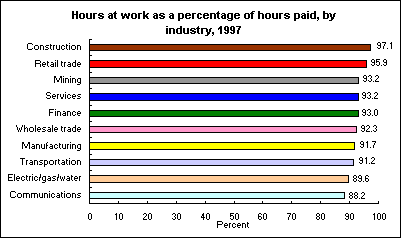An official website of the United States government
 United States Department of Labor
United States Department of Labor
Workers in the communications industry received the most paid leave compared to their hours paid of any industry in 1997.

[Chart data—TXT]
Nonsupervisory employees in communications worked 88.2 percent of their paid hours, well below the average of 93.4 percent for all nonfarm workplaces. In one other industry—electric, gas, and sanitary services—employees also worked less than 90 percent of their paid hours.
For most major industries, the percentage of hours at work relative to hours paid was above 90.0 percent and at least slightly below the average of 93.4 percent. This group includes 6 of the 10 industries shown in the chart.
Construction workers received the least amount of paid leave: 2.9 percent of their paid hours were in the form of leave, for an hours-worked-to-hours-paid ratio of 97.1 percent. Retail trade workers also received less paid leave than average in comparison to their hours paid.
The data used in this article were produced by the BLS Hours at Work Survey. Information on this survey is available from the BLS Multifactor Productivity program. Find out more in chapter 3 of Report on the American Work Force 1999 (PDF 1,037K). These data are for production workers and nonsupervisory employees.
Bureau of Labor Statistics, U.S. Department of Labor, The Economics Daily, Communications workers get the most paid leave at https://www.bls.gov/opub/ted/1999/oct/wk1/art03.htm (visited December 30, 2025).

